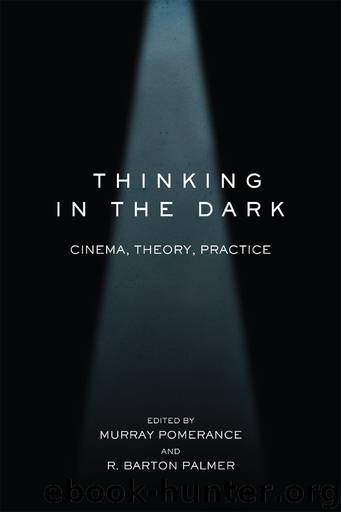Thinking in the Dark by Unknown

Author:Unknown
Language: eng
Format: epub
Publisher: Rutgers University Press
Published: 2015-06-15T16:00:00+00:00
FIGURE 12.1 Bogart hidden and revealed in Dark Passage (Delmer Daves, Warner Bros., 1947). Digital frame enlargements.
Vincent Parry’s new face is meant to be anonymous, the face of no one alive, so that he cannot be easily tracked. Yet he is given Bogart’s face, a visage so famous it inspired Michel Poiccard (Jean-Paul Belmondo) in Breathless (1960), when that escapee was also being tracked down. Cities make one feel anonymous, yet under surveillance.4 Dark Passage represents this existentialist anguish; it thematizes identity, guilt, and the otherness (the “hell,” Jean-Paul Sartre would say) of other people and a deeper otherness within ourselves.
Destiny
While the mystery of the neo-realist face may be seen in Bogart’s, the loose neo-realist plot is the opposite of the “mystery story” that makes up Dark Passage. Neo-realism can afford to abjure montage, whereas Dark Passage requires a good deal of editing before Vincent Parry can make it through the birth canal of the plot to be reborn in a seaside Peruvian Eden.
In a two-part examination of the policier—and calling on Aristotle to distinguish it from tragedy—Bazin first analyzed what he called the “physics” of its mechanism (plot) before turning to the “chemistry” of its substance (character). I have begun with the chemical makeup of Dark Passage, because this film’s distinctiveness lies precisely in the chemistry of its hero, or rather in the way the film almost scientifically tests that chemistry through an experiment with the special effect of plastic surgery. Bazin identified the noir hero by a peculiar molecular combination involving elements of both criminal and detective, and he held up Humphrey Bogart’s Philip Marlowe as an unalloyed example (see “Le film policier”). Vincent Parry is not so clear a specimen but, once given a new face, he feels transformed from someone who is technically a criminal on the run (condemned as such) into a detective hunting down the real killer. With his original face he feared every person he ran into, every knock at the door; he cowered upstairs and peered from behind the blinds, sure that he was being spied upon. But with a new face, and as Humphrey Bogart, he starts acting like Philip Marlowe: “I’ve got to prove who killed him,” he says. Now it will be he who turns the table on the blackmailer when the latter knocks on his hotel door. Bogart wrests the gun from him and forces answers from him in a brutal interrogation. Next, he knocks on Madge’s door and corners her. Both his tormenters wind up in panic, falling to their deaths from a great height.
Like all noir heroes, Parry plays hide and seek in a murky world. “Caught within the ambiguity of events, it’s not he who is immoral; rather it is morality that gives way under his footsteps. For duty and crime appear to be desperately relative notions when seen under the light of a series of actions that are always duplicitous and perpetually disguised” (Bazin, “Grandeur”).
Vincent Parry’s “destiny” moves in but one direction through Dark Passage.
Download
This site does not store any files on its server. We only index and link to content provided by other sites. Please contact the content providers to delete copyright contents if any and email us, we'll remove relevant links or contents immediately.
Adulting by Kelly Williams Brown(4486)
Drawing Cutting Edge Anatomy by Christopher Hart(3453)
Figure Drawing for Artists by Steve Huston(3380)
Draw Your Day by Samantha Dion Baker(3286)
Drawing Shortcuts: Developing Quick Drawing Skills Using Today's Technology by Leggitt Jim(2996)
Make Comics Like the Pros by Greg Pak(2852)
Rapid Viz: A New Method for the Rapid Visualization of Ideas by Kurt Hanks & Larry Belliston(2833)
0041152001443424520 .pdf by Unknown(2784)
How Proust Can Change Your Life by Alain De Botton(2742)
Draw to Win: A Crash Course on How to Lead, Sell, and Innovate With Your Visual Mind by Dan Roam(2732)
How The Mind Works by Steven Pinker(2729)
Day by Elie Wiesel(2717)
Draw-A-Saurus by James Silvani(2655)
Tattoo Art by Doralba Picerno(2599)
Modern Cartooning by Christopher Hart(2557)
Learn Drawing Quickly by Sharon Finmark(2520)
Poses for Artists Volume 2 - Standing Poses: An essential reference for figure drawing and the human form. (Inspiring Art and Artists) by Justin Martin(2518)
Drawing and Painting Birds by Tim Wootton(2438)
Poses for Artists - Dynamic & Sitting: An essential reference for figure drawing and the human form (Inspiring Art and Artists Book 1) by Justin R Martin(2433)
